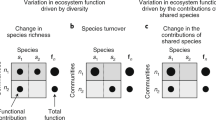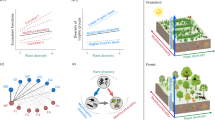Abstract
Resolving current concerns about the role of biodiversity on ecosystems calls for understanding the separate roles of changes in species numbers and of composition. Recent work shows that primary productivity often, but not always, saturates with species richness within single trophic levels1,2,3,4,5,6,7,8. However, any interpretation of such patterns must consider that variation in biodiversity is necessarily associated with changes in species composition (identity)9,10,11,12, and that changes in biodiversity often occur across multiple trophic levels13,14. Here we present results from a mesocosm experiment in which we independently manipulated species richness and species composition across multiple trophic levels in pond food webs. In contrast to previous studies that focused on single trophic levels, we found that productivity is either idiosyncratic or increases with respect to species richness, and that richness influences trophic structure. However, the composition of species within richness levels can have equally or more marked effects on ecosystems than average effects of richness per se. Indirect evidence suggests that richness and associated changes in species composition affect ecosystem attributes through indirect effects and trophic interactions among species, features that are highly characteristic of natural, complex ecosystems.
This is a preview of subscription content, access via your institution
Access options
Subscribe to this journal
Receive 51 print issues and online access
$199.00 per year
only $3.90 per issue
Buy this article
- Purchase on SpringerLink
- Instant access to full article PDF
Prices may be subject to local taxes which are calculated during checkout


Similar content being viewed by others
References
Chapin, F. S. III et al. Consequences of changing biodiversity. Nature 405, 234–242 (2000).
Schläpfer, F., Schmid, B. & Seidl, I. Expert estimates about effects of biodiversity on ecosystem processes and services. Oikos 84, 346–352 (1999).
Schwartz, M. W. et al. Linking biodiversity to ecosystem function: implications for conservation ecology. Oecologia 122, 297–305 (2000).
Hector, A. et al. Plant diversity and productivity experiments in European grasslands. Science 286, 1123–1127 (1999).
Symstad, A. J., Tilman, D., Willson, J. & Knops, J. M. H. Species loss and ecosystem functioning: effects of species identity and community composition. Oikos 81, 389–397 (1998).
Tilman, D., Wedin, D. & Knops, J. Productivity and sustainability influenced by biodiversity in grassland ecosystems. Nature 379, 718–720 (1996).
Tilman, D. et al. The influence of functional diversity and composition on ecosystem processes. Science 277, 1300–1302 (1997).
van der Heijden, M. G. A. et al. Mycorrhizal fungal diversity determines plant biodiversity, ecosystem variability and productivity. Nature 396, 69–72 (1998).
Huston, M. A. Hidden treatments in ecological experiments: re-evaluating the ecosystem function of biodiversity. Oecologia 110, 449–460 (1997).
Grime, J. P. Biodiversity and ecosystem function: the debate deepens. Science 277, 1260–1261 (1997).
Aarssen, L. W. High productivity in grassland ecosystems: effected by species diversity or productive species? Oikos 80, 183–184 (1997).
Huston, M. A. et al. No consistent effect of plant diversity on productivity. Science 289, 1255a (2000).
Petchey, O. L., McPhearson, P. T., Casey, T. M. & Morin, P. J. Environmental warming alters food-web structure and ecosystem function. Nature 402, 69–72 (1999).
Wilcove, D. S., Rothstein, D., Dubow, J., Phillips, A. & Losos, E. Quantifying threats to imperiled species in the United States. BioScience 48, 607–615 (1998).
Hooper, D. & Vitousek, P. M. The effects of plant composition and diversity on ecosystem processes. Science 277, 1302–1305 (1997).
Mikola, J. Effects of microbivore species composition and basal resource enrichment on trophic-level biomasses in an experimental microbial-based soil food web. Oecologia 117, 396–403 (1998).
Norberg, J. Resource-niche complementarity and autotrophic compensation determines ecosystem-level responses to increased cladoceran species richness. Oecologia 122, 264–272 (2000).
McGrady-Steed, J., Harris, P. M. & Morin, P. J. Biodiversity regulates ecosystem predictability. Nature 390, 162–165 (1997).
Naeem, S., Thompson, L. J., Lawler, S. P., Lawton, J. H. & Woodfin, R. M. Declining biodiversity can alter the performance of ecosystems. Nature 368, 734–737 (1994).
Naeem, S., Hahn, D. & Schuurman, G. Producer-decomposer co-dependency influences biodiversity effects. Nature 403, 762–764 (2000).
Wetzel, R. G. Limnology (Saunders College Publishing, Orlando, 1983).
Pimm, S. L., Russell, G. J., Gittleman, J. L. & Brooks, T. M. The future of biodiversity. Science 269, 347–350 (1995).
Lund, O. T. Handbook of Common Methods in Limnology (Mosby Company, St Louis, 1979).
Tilman, D., Lehman, C. L. & Thomson, K. T. Plant diversity and ecosystem productivity: theoretical considerations. Proc. Natl Acad. Sci. USA 94, 1857–1861 (1997).
de Ruiter, P. C., Neutel, A.-M. & Moore, J. C. Energetics, patterns of interaction strengths, and stability in real ecosystems. Science 269, 1257–1260 (1995).
Sand-Jensen, K. & Borum, J. Interactions among phytoplankton, periphyton, and macrophytes in temperate freshwaters and estuaries. Aquat. Bot. 41, 137–175 (1991).
McCollum, E. W., Crowder, L. B. & McCollum, S. A. Complex interactions of fish, snails, and littoral zone periphyton. Ecology 79, 1980–1994 (1998).
Martinez, N. D. Artifacts or attributes? Effects of resolution on the Little Rock Lake food web. Ecol. Monogr. 61, 367–392 (1991).
Wootton, J. T. The nature and consequences of indirect effects in ecological communities. Annu. Rev. Ecol. Syst. 25, 443–466 (1994).
Yodzis, P. in Food Webs: Integration of Patterns and Dynamics (eds Polis, G. A. & Winemiller, K. O.) 192–200 (Chapman and Hall, New York, 1996).
Acknowledgements
We thank S. Naeem, J. T. Wootton, J. Bergelson, C. Pfister and M. Huston for comments on the manuscript, and J. Chase and J. Shurin for help in the field. The paper is a Kellogg Biological Station contribution, and was supported by grants from the National Science Foundation, US Department of Education, and the University of Chicago.
Author information
Authors and Affiliations
Corresponding author
Ethics declarations
Competing interests
The authors declare that they have no competing financial interests
Supplementary information
Rights and permissions
About this article
Cite this article
Downing, A., Leibold, M. Ecosystem consequences of species richness and composition in pond food webs. Nature 416, 837–841 (2002). https://doi.org/10.1038/416837a
Received:
Accepted:
Issue Date:
DOI: https://doi.org/10.1038/416837a
This article is cited by
-
Omnivore density affects community structure through multiple trophic cascades
Oecologia (2021)
-
Effects of a fire retardant on the Near Eastern Fire Salamander Salamandra infraimmaculata and aquatic community structure: an experimental approach
Hydrobiologia (2021)
-
Species identity drives ecosystem function in a subsidy-dependent coastal ecosystem
Oecologia (2021)
-
Effects of urban infrastructure on aquatic invertebrate diversity
Urban Ecosystems (2020)
-
Decomposition rates of fine roots from three herbaceous perennial species: combined effect of root mixture composition and living plant community
Plant and Soil (2017)



